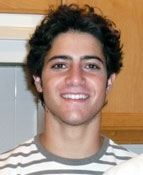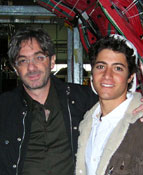Essay: Jordan Sorokin
 |
| Photos courtesy of Jordan Sorokin |
A future in physics
My body is a tiny composition of molecules, insignificant compared to the three-story-high particle detector towering over the various tanks, wires, and steel tubing from which it had been constructed.
I can hear the workers busily discussing a compilation of data to create a coherent model; I can smell and taste the metallic ashes and electrical wiring running through the accelerator; I can feel the curious atmosphere—the atmosphere of scientific breakthroughs and historical significance—resting gently on my shoulders, and I smile.
My legs carry the mass of my body through the endless corridors of the particle accelerator at Fermilab in Illinois, as I tune in to a private lecture about the work being done at the multicomputer monitor station to my left, and the various Standard Model particles discovered, to my right. As we slowly wander through the lab, Jacobo Konigsberg—a renowned scientist at Fermilab who helped discover the top quark— describes to my father and me the steps he and his colleagues took in facilitating the discovery of the particle.
My eyes water from not blinking, but I dont care; I continue to absorb every ounce of information I can as I learn about the top quark, neutrinos, and the fundamental questions of dark matter, dark energy, the formation of gravity, and the big bang theory. I crawl down a flight of stairs towards the superconducting magnets lined up evenly along the accelerators boundary, and I feel my heart skip a beat, pounding at my chest in marvel.
The personal appointment comes to an end, and Dr. Konigsberg asks, So Jordan, do you have any questions? Oh boy, he certainly doesnt know what he just got himself into!
After visiting Fermilab, I knew that I had only one passionate aspiration, one life-long quest: to become a physicist. The visit sparked an interest inside of me, like an electrical wire jerking sporadically with every ounce of new knowledge; I began researching particle physics, as well as astrophysics last year, and have continued my research since. Virtually every day I find myself peering at my computer monitor, searching for answers to my questions: What is dark matter? How was time suddenly created? Theoretically, isnt it possible to accelerate a particle faster than the speed of light with an indefinite amount of energy, and if so, wouldnt it travel back in time to a point when the Tevatron that accelerated it did not exist?
 |
| Jordan Sorokin takes a tour of Fermilab with Jacobo Konigsberg. |
There are so many questions, so many theories that I have weaving throughout my mind, yet that I have never found a definite answer for. This constant search for answers, although a burden to many, is the only plausible path that I see myself taking as I grow older (not necessarily finding the answers, merely seeking them). My happiness is only guaranteed when my temples ache with information, my eyes film near the edges, and my knowledge and questions expand.
Fermilab has not only exposed to me the processes and research involved in fundamental breakthroughs in the understanding of our world and the technology available, but has also demonstrated the potential wealth of understanding and wisdom the human mind can obtain if the desire and zeal is strong enough.
I have seen first-hand what it means to be a physicist, and I love it. I love the sounds, the smells, the tastes I even love the stress that comes along with data! Moreover, I love the fact that I have found something I am truly and undeniably passionate for, something that I know I will be researching and theorizing about in my soon-to-be professional career.
Jordan Sorokin is a senior at La Costa Canyon High School, Carlsbad, CA, and plans to major in physics at a university.
Click here to download the pdf version of this article.


